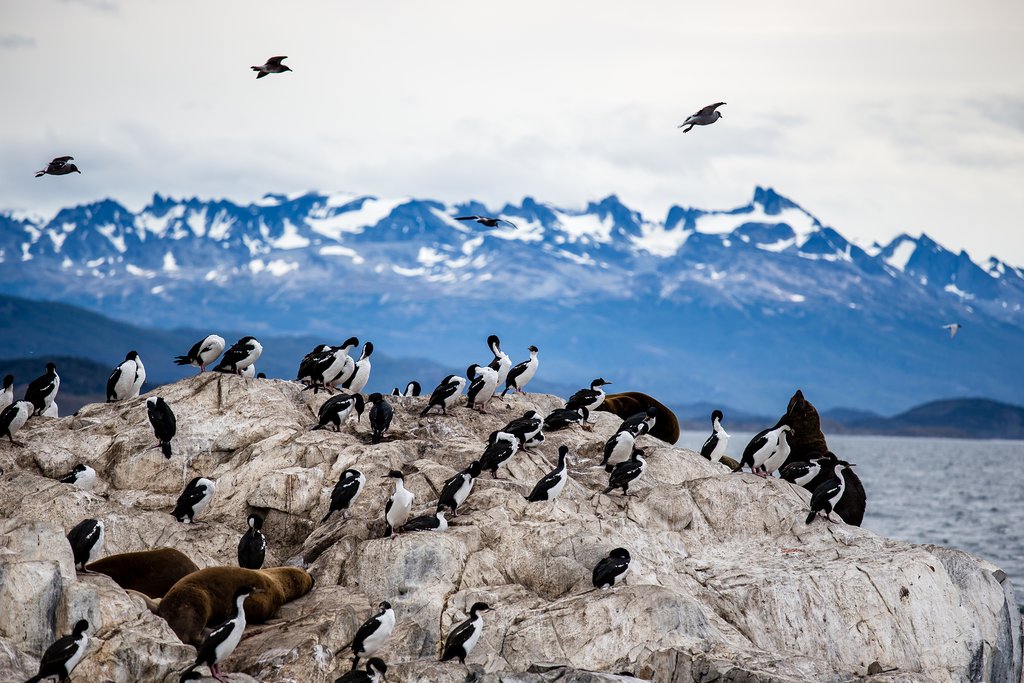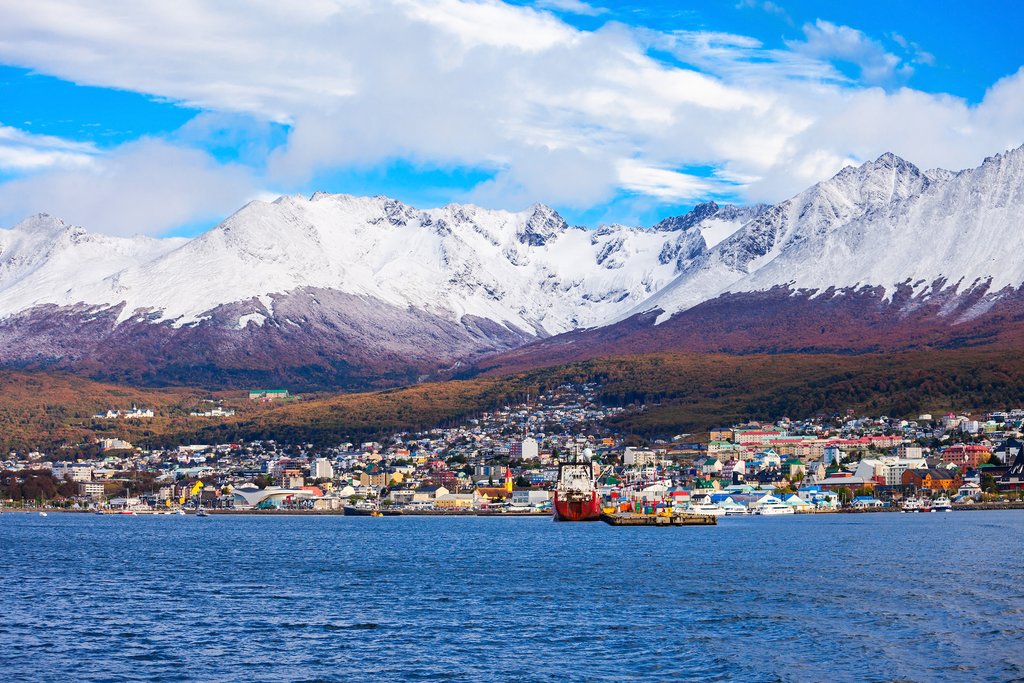Discovering Ushuaia
Ushuaia is the capital of Argentine Tierra del Fuego, the archipelago divided between Argentina and Chile below Patagonia, at the very bottom of South America. Home to around 70,000 people, the city is a tourist hub for the region with a busy port and profitable manufacturing industry. Nevertheless, it still retains something of a frontier feel and has adopted the slogan “El Fin del Mundo:" The End of the World.
Indigenous people inhabited Tierra del Fuego for around 10,000 years, but the arrival of European settlers in the 1850s and the multi-national cast of gold prospectors and sheep ranchers who followed in their wake had a devastating impact on them. Sovereignty disputes with Chile prompted the Argentine government to establish a penal colony here in 1896 and a town soon grew up around it. The prison closed in 1947, but Ushuaia continued to thrive.
Today, despite its remoteness and bracing climate, the city is a fascinating place in its own right, as well as a launchpad for wider explorations of wild and wonderful Tierra del Fuego.
Planning Your Visit

Aim to spend a minimum of three days in Ushuaia: this allows you a day in the national park, a half-day cruise on the Beagle Channel and a day looking around the city’s various museums. If you want to do some winter sports or explore further afield, a 6-day stay is preferable. Most travelers combine Ushuaia with a wider visit to Patagonia, such as on this 15-day itinerary.
Ushuaia has several banks with ATMs—though the latter sometimes run out of cash over the weekend—plenty of places change foreign currency, and credit/debit cards are widely accepted. For more practical logistics, see our Argentina FAQ.
Weather
The weather in Ushuaia isn’t quite as extreme as you might expect. The warmest period is between November and March, when daytime temperatures can reach 50-54°F (10-12°C). From May to August, the winter sports season, temperatures rarely exceed 41°F (5°C) and often drop well below zero with a gusting wind that can make it feel far colder. It rains throughout the year in Ushuaia, so bring a waterproof jacket.
Getting There & Away
Ushuaia’s airport, on the edge of the city, has daily flights to Buenos Aires, El Calafate, and Trelew in Argentina and weekly ones to Punta Arenas in Chile. Most are with Aerolineas Argentinas or LATAM.
Long-distance buses arrive at and depart from their respective company offices—there’s no single terminal. During the warmer months (roughly November-March), there are daily departures to Río Grande, the second biggest town in Argentine Tierra del Fuego, Río Gallegos in mainland Patagonia, and Punta Arenas and Puerto Natales in Chile.
Ushuaia is the main port for Antarctic cruises; there are also regular boats across the Beagle Channel to Puerto Williams (the southernmost town on earth) in Chile and tourist cruises to Punta Arenas.
Transport Options
Ushuaia is a compact, walkable city, though plenty of taxis are available. Several car hire outlets have offices at the airport; they don’t allow you to take vehicles out of Argentina. The Tren del Fin del Mundo (End of World Train) is a fun experience, but not practical for getting from A to B.
Chat with a local specialist who can help organize your trip.
Highlights & Things to Do

The rugged mountain landscapes and shimmering waters surrounding Ushuaia are the major attractions, offering plenty of opportunities for hiking, cruises, wildlife-spotting, and winter sports. The city itself boasts a remarkable museum, while a historic ranch lies within easy striking distance.
Beagle Channel
Named after the ship that carried Charles Darwin around the world, the Beagle Channel is home to sizeable sea lion colonies, Peale’s dolphins, and even minke whales, as well as an array of birdlife including albatrosses, petrels, and skuas. Moreover, the views of Ushuaia and the mountain ranges beyond are truly spectacular. You can take a cruise around the channel, typically lasting 3-4 hours.
Tierra del Fuego National Park
Spanning some hundreds of miles and crisscrossed with hiking trails, Tierra del Fuego National Park is an essential day trip from Ushuaia. It encompasses Andean peaks, gleaming lakes, sub-Antarctic tundra, and dense beech forests populated by Magellanic woodpeckers, condors and austral parakeets. You can catch the aforementioned Tren del Fin del Mundo (End of the World Train) for part of the journey to the park.
Maritime and Prison Museum
Ushuaia’s former prison has been turned into a highly impressive museum. There are sections on the region’s maritime history and Antarctica, as well as an art gallery. But the most interesting displays are on how the prison's establishment sparked the development of Tierra del Fuego at the turn of the twentieth century, and the fearsome array of inmates who were held here. One wing has been left unrestored and the stark cells are wonderfully evocative.
Estancia Harberton
Located about 40 miles east of Ushuaia, Harberton was the first estancia (ranch) in Tierra del Fuego, founded by British missionaries in 1886. Today it is possible to visit the homestead, which offers an insight into the history of the region. There’s an interesting marine mammal museum here and offshore Martillo Island is home to large colonies of Magellanic and gentoo penguins, plus a few king penguins.
Take a day trip to Harberton with a guide or simply drive yourself; if you have the time, it’s worth staying overnight. For more about spending the night on traditional estancias, see Beyond Hotels: Unique Lodging Options in Argentina.
Winter sports
Ushuaia—or more specifically, the mountains surrounding it—is a popular winter sports destination, with the season generally running from June through August. Downhill and cross-country skiing, snowboarding, dog-sledding, and snow-shoeing are among the activities on offer. Just east of Ushuaia, Cerro Castor, offers 14 miles of ski runs.
Festivals & Special Events
There are relatively few festivals or events of note for tourists in Ushuaia. On June 12, the winter solstice, the city celebrates the Festival Nacional de la Noche Más Larga (National Longest Night Festival), which features live music, cultural activities, and fireworks displays. Marcha Blanca, the annual ski marathon, takes place in August, while the Festival Internacional de Ushuaia (Ushuaia International Festival) features world music performances.
Lodging & Dining

Where to Stay
Ushuaia has lots of hostels and high-end hotels, though good mid-range options are in relatively short supply. Prices across the board are higher than elsewhere in Argentina and the best places fill up fast, so book well in advance. Note that tourists who pay for their accommodation in Argentina with a foreign debit/credit card are exempt from VAT (known locally as IVA and currently standing at 21%).
Antarctica Hostel and La Posta are the pick of the budget options. Mid-range travelers should head to Hotel Austral or B&B Galeazzi-Basily, both friendly, well-run establishments. The best top-end hotels are outside the city center: Arakur, high on a hill overlooking the Beagle Channel, has modern en suites and glorious swimming pools; Tierra de Leyendas is an exquisite boutique hotel with owners who whip up fantastic meals.
Where to Eat
Ushuaia has some great places to eat and drink, but there are also plenty of tourist traps. As with accommodation, prices are on the high side. Centolla (king crab) is the main local delicacy: make sure you get it fresh, rather than frozen.
The most sophisticated restaurant is Kalma Restó, which has a creative, internationally inspired menu—prices, though, are on the high side. Fish and seafood are the stars at family-run Kaupé, while atmospheric Ramos Generales offers hearty soups, sandwiches, and stews, as well as delectable sweet and savory pastries.
Given the local climate, ice cream is not the most obvious choice down here, but you can’t visit Argentina without a trip to national institution Freddo. The various dulce-de-lecheflavorss are the highlights. Ushuaia’s nightlife is rather tame, but Küar is an appealing spot for a drink, with a good range of craft beers and Argentine wines.
